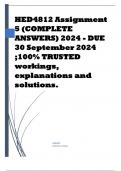HED4812 Assignment
5 (COMPLETE
ANSWERS) 2024 - DUE
30 September 2024
;100% TRUSTED
workings,
explanations and
solutions.
ADMIN
[COMPANY NAME]
, Understanding (10 Marks): 1. Define the key indigenous and traditional
leadership principles discussed in the module. How do these principles
contribute to fostering cultural diversity within educational leadership? 2.
Provide examples of indigenous and traditional leadership practices that you
find particularly relevant to educational leadership. How might these practices
be applied in a modern educational setting? Integration (15 Marks):
Understanding:
1. Key Indigenous and Traditional Leadership Principles: Indigenous and traditional
leadership principles are deeply rooted in cultural values, community connections, and
holistic approaches to governance. Some key principles discussed in the module include:
a. Community-Centered Decision Making: Decisions are made with the input and
consensus of the community, emphasizing collective well-being over individual interests.
b. Interconnectedness with Nature: Leaders recognize the symbiotic relationship
between humans and nature, promoting sustainability and environmental stewardship.
c. Respect for Elders and Ancestors: Elders hold wisdom and experience, and their
guidance is highly valued in decision-making processes.
d. Oral Tradition and Storytelling: Communication and knowledge transfer often occur
through oral traditions, preserving cultural heritage and passing down wisdom through
generations.
e. Spiritual Connection: Leadership is imbued with spiritual practices, acknowledging
the spiritual dimension of life and its influence on decision making.
These principles contribute to fostering cultural diversity within educational leadership
by honoring diverse perspectives, valuing community voices, and promoting inclusivity.
They offer alternative frameworks for leadership that prioritize relationships,
sustainability, and collective well-being, which are essential for creating culturally
responsive educational environments.
2. Examples of Relevant Indigenous and Traditional Leadership Practices:
a. Circle Leadership: In many Indigenous cultures, decision making occurs in a circle
format, where everyone has a voice and decisions are made through consensus. This
practice can be applied in modern educational settings through collaborative decision-
making processes, such as faculty meetings or student councils, where diverse voices are
heard and respected.




